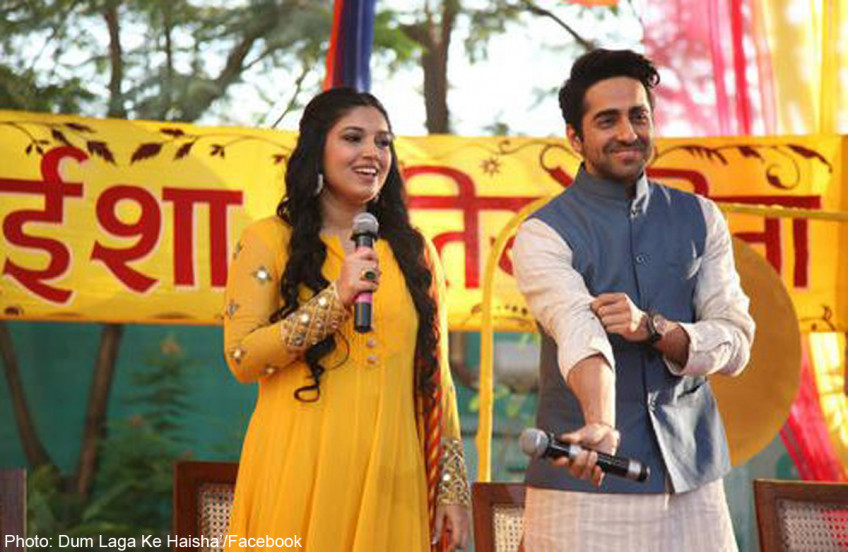Indians plump for curvy actresses

The Indian woman has been portrayed in art for millennia as spectacularly curvaceous, with an ample bosom and generous hips, until the Western ideal of a waif-like form appeared in Hindi films around the turn of the century.
Now, with the weighty debut of plump newcomer Bhumi Pednekar, the tide seems to have turned.
Pednekar, 25, has received glowing reviews for her film Dum Laga Ke Haisha (Give In All Your Energy). The romantic comedy is about a woman who has an arranged marriage to a small town loser who is far less smart and accomplished then she is, but she finds that it is she who is at a disadvantage because she is fat.
Pednekar says: "As a kid, I was tubby but it was never an issue at home with my family. No one commented on it and no one ever made me feel self-conscious. It's just the way I am."
The film portrays her in the same way, as a fat woman who has no desire to go on a diet. In a "normal" Hindi film, the happy ending would have required her to lose weight, becoming slim, but not in this film; its tagline is "Love comes in all sizes".
To understand the revolution this actress has ushered in, you have to recall that actress Kareena Kapoor, with her size zero, has been the role model for a generation of young Indian women. Not a single female lead in Indian films, at least in the north, has been anything but slim.
"This is the result of a couple of factors. One is the growing adoption of Westernised ideals of beauty rather than Indian, and the other is the influx of models and beauty queens and Miss India winners in the film industry," said film critic Komal Nahta. "They came in with toned bodies and not an ounce of fat and that became the desirable female form."
The Indian film industry did not become obsessed with slim figures until about 15 years ago.
"Earlier, directors emphasised a heroine's face, eyes and expressions rather than her body. They had to be voluptuous, not fit," said New Delhi film buff Parsa Venkateshwar Rao.
The only exception to "thin is best" these days is when actresses play chunky women, such as Vidya Balan in The Dirty Picture. In fact, "Bechari Balan" ("Poor Balan" as she has been called) has been the butt of relentless media cristicisms over her "meaty legs" and "love handles".
The moment an actress reveals even the slightest bit of fat, the press denounces her as a frump. Parineeti Chopra, Sonam Kapoor and Aishwarya Rai have all been dissected for signs of fat and - if found - flagellated for it.
Despite her superstar status, Rai received much flak for not regaining her figure quickly enough after giving birth to a baby girl in 2011, as though it was meant to return to its pre-pregnancy contours in a flash. The criticism levelled at her was fierce and unforgiving.
Now that she has lost weight, the 41-year-old actress has predictably been praised for how stunning she looks on the cover of the March issue of Vogue India.
Pednekar's success - assuming she keeps getting roles and this film is not a flash in the pan - shows tastes coming full circle because Indian men have always preferred the fuller female figure.
Historically, being thin was associated with being poor and badly nourished and therefore belonging to a lower social class.
Having more flesh on the bone was indicative of prosperity, a belief that still holds in the less educated parts of India where fat men and women almost flaunt their paunches as if to say: "Yes, look at me, I'm rich enough to be fat." In rural Punjab, men used to drink cups of melted butter to get fat and achieve the "prosperous" look.
Many women have applauded this return to the earlier feminine ideal in Pednekar. Ms Puravi Kapoor, 22, a commerce student in the capital New Delhi, said: "For the first time in years, I was watching someone on screen who had the same body shape as me. Because she looks like a real woman, she is an inspiration to me and other big women."
Pednekar's role presents another breakthrough where size zero actresses are no longer typecast as the "usual" Hindi film heroine being pursued by a suitor and eventually succumbing.
Balan made a breakthrough portraying dancing queen Silk Smitha in The Dirty Picture in 2011. In last year's Queen, Kangna Ranaut played a New Delhi girl who goes off alone on her honeymoon to Paris and Amsterdam after her fiance dumps her. Last year, Rani Mukherjee played a police officer chasing child traffickers in the crime thriller Mardaani (The Manly She).
"These roles were unconventional and they paved the way for what I've done in this film," said Pednekar. "There is much more scope for women to play varied roles and that now includes playing someone who is fat. I'm sure other barriers will be broken down soon too."
amritdylan@gmail.com

This article was first published on Mar 16, 2015.
Get a copy of The Straits Times or go to straitstimes.com for more stories.